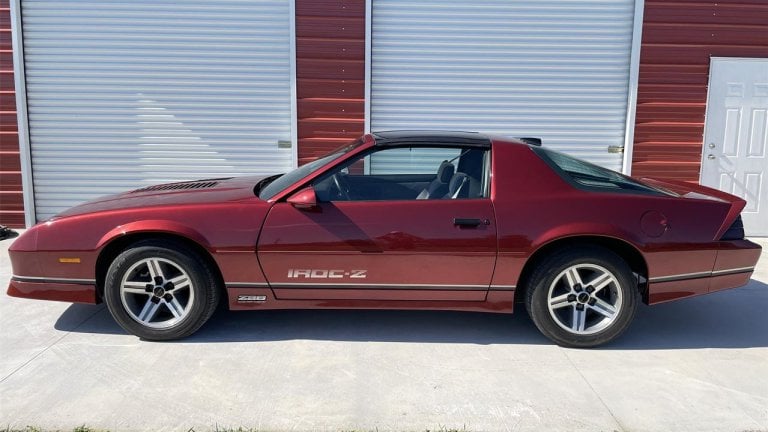Some interesting finagling has been cooking over at General Motors. Chairman and CEO Mary Barra, a brilliant electrical engineer in her own right, has outwardly embraced the Chevrolet Camaro and Pontiac Firebird as her all-time favorite GM cars. But like most auto manufacturers of today, Barra is looking to electrification for the future of the iconic 112-year-old OEM — to the chagrin’ of many performance enthusiasts — and “pulling the plug” on the sixth-generation Chevrolet Camaro.

2018 Camaro SS (Photo: Chevrolet)
The Camaro has been an on-again off-again phenomenon at General Motors. In 2024, the Bowtie brand will cease manufacturing the iconic model that saw its beginning in 1967. The F-body enjoyed four generations of production before getting axed in 2002. The Camaro saw a rebirth in 2010 in the retro-styled fifth-gen F-Body. So it seems, sadly, that we are writing yet another eulogy for an internal combustion performance legend.
“Chevrolet made the decision now as a part of continuously evaluating our portfolio offerings for progress toward our EV future and sales demand,” announced GM Spokesperson Trevor Thompkins when speaking to the Detroit Free Press

1969 Camaro Z-28 RS (Photo: Mecum Auctions)
The fifth-generation F-body pony car came at a time when design was focused on retro styling. Automakers around the world were throwing concepts to the public in hopes of attracting the aging yuppie baby boomers in what could conceivably be close to their last special interest car purchase. Here was a chance to own modern interpretations of their dream cars from the 1960s.
Dodge did it with the reborn Challenger, Ford with the Thunderbird and the GT, Chrysler with the 300, and even Fiat with the economical 500. The only perpetual model of the legendary pony cars has been Ford’s Mustang — which also went with a retro-style design with its fifth-generation S197 in 2005.
Unfortunately, business is business, they say. Passion is bullshit. Many of us have learned that lesson more than a few times in our life.
There is a myriad of reasons for the death of the performance sedan. Firstly is the marketplace. The beginning of the end goes back to 1984 when Lee Iacocca introduced the world to the minivan. Iacocca’s post at Chrysler, as CEO, saw him trying to rescue the automaker from ruin and soliciting US President Ronald Reagan for help. The K-car and the minivan were just the formula that brought the embattled OEM back from the perils of Chapter 11 bankruptcy along with an influx of federal money — which was paid back with interest. Several bailouts later for the Big 3 automakers, they are now taking significant influence and direction from the government.

1967 Camaro SS (Photo: Auto Hunter)
Lee Iacocca, indecently, was also known as the father of the Mustang during his long tenure at Ford. However the Mustang — the original pony car in concept — was not a performance-driven vehicle. It was an economical, well-designed car specifically targeted toward the rise of the career woman. Call it a “secretary’s car.” However, it wasn’t long before V8s were being shoehorned into the nimble chassis, giving way to the performance legend that exists today — with no end in sight.
The Chrysler Town and Country minivan, with its boxy exterior and wood paneling, became the official vehicle of the “Nuclear Family.” Baby boomers and their growing 2.5-kid families required spacious, economical vehicles that proved capable transportation to little league baseball games, trips to the grocery store, and long road adventures. The minivan never left, but the concept would combine with the growing popularity of off-road trucks, evolving into the Sport Utility Vehicle (SUV) which has become the most popular OEM offerings selling today. Go to a Porsche dealer, for example. The sports cars that once adorned the retailer lots and wowed the faithful, now are surrogated with Macan and Cayenne SUV models.

1986 IROC-Z (Photo: Auto Hunter)
The next important reason is a mixture of environmental concerns and good old-fashioned capitalism. Going electric seems to be the mantra for everyone including numerous world governments and the manufacturers themselves. Further pressure comes from activist investors — top stockholders “with a conscience.”
Environmentalists, who are amongst the world’s most ignorant and under-informed people, think that child labor; gigantic, hazardous Chinese lithium mines; and batteries, with a finite lifespan are the answer to clean air and a more inhabitable and sustainable earth. This, despite the amazing evolution of efficiency and lower carbon footprint of modern internal combustion engines.
Governments got behind the move to electrification and, in turn, cashed checks from China (who own an almost complete monopoly on lithium) to impose and incentivize automobile manufacturers to abandon fossil-fueled vehicles. This, despite the leaders of these governments still being chauffeured around in full-size, armored, gas-guzzling SUVs and private jets.

1970 Z-28 (Photo: American Muscle Car Museum)
Lastly, and perhaps most important, is sales. The fifth-generation Camaro, designed in partnership with Australia’s Holden, sold over 81,000 units in 2010, but in 2022 the sixth-gen Camaro only moved 24,000 vehicles. Part can be attributed to inventory shortages and the great chip stoppage of 2020’s pandemic-infested world. From a business standpoint, regardless, that was the last nail in the coffin for the legendary pony car.
Word on the street is the Camaro nameplate will eventually get a reboot — as it is a valuable Chevrolet brand name. However, it will be attached to an EV, possibly like Ford’s Mustang Mach E.
Farewell Camaro. We knew and loved you well.



